Business Finance Report: Cash Budgeting and Analysis - MOD003319
VerifiedAdded on 2022/11/30
|13
|3369
|304
Report
AI Summary
This report provides a comprehensive analysis of business finance, focusing on critical concepts such as cash flow, working capital, and cash budgeting. It begins by defining profit and cash flow, highlighting their differences, and explaining how changes in working capital affect cash flow. The report then delves into practical applications, including the preparation of a monthly cash budget for a hypothetical company, Thorne Estate Limited, and offers observations and recommendations to improve cash flow management. The analysis covers key financial components like accounts receivable, inventory, and accounts payable, and suggests strategies to optimize cash flow, manage inventory, and improve financial performance through effective working capital management. The report emphasizes the importance of timely transactions, efficient inventory management, and proactive management of payables and receivables to enhance a company's financial health and achieve its business goals.

Business Finance
Paraphrase This Document
Need a fresh take? Get an instant paraphrase of this document with our AI Paraphraser

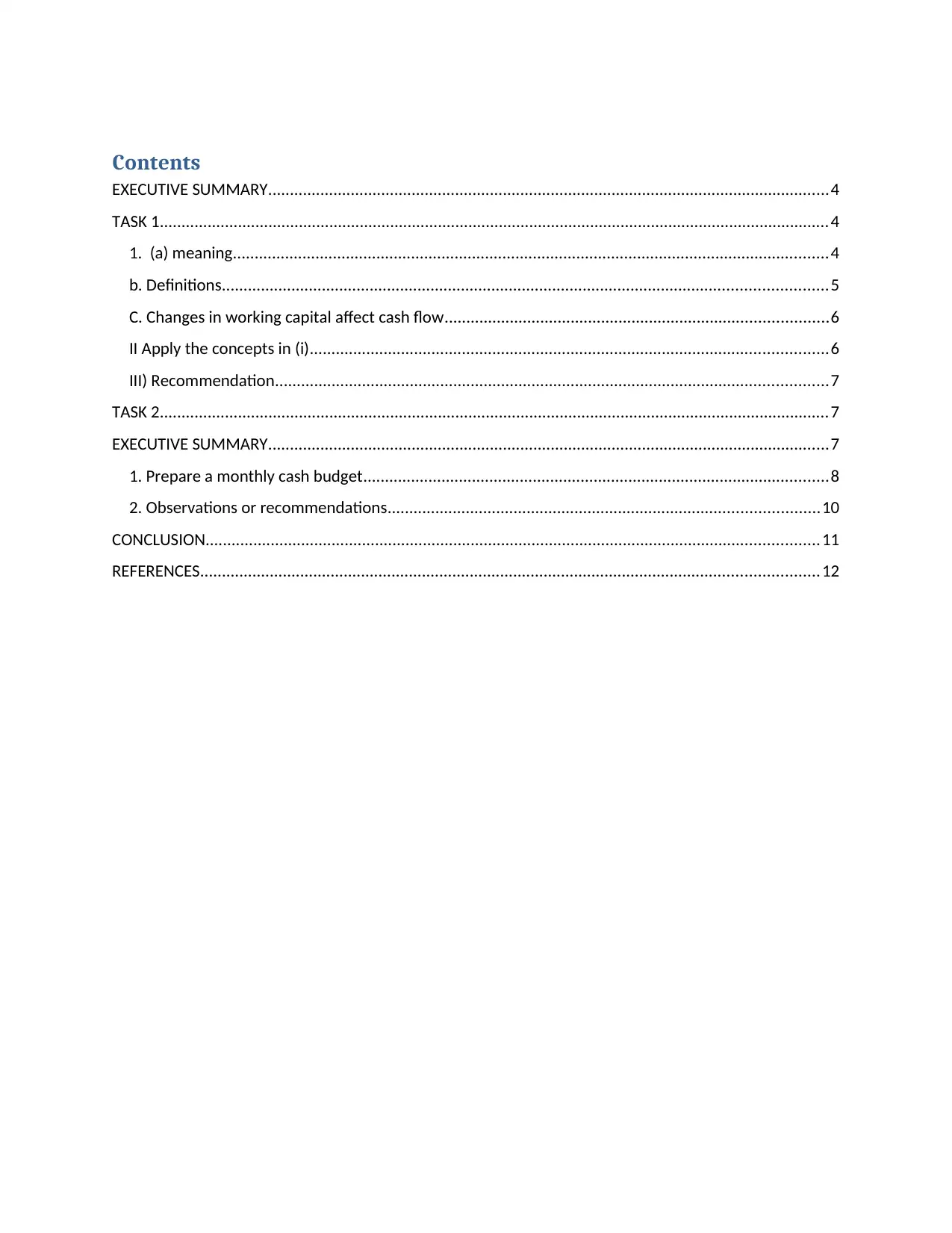
Contents
EXECUTIVE SUMMARY.................................................................................................................................4
TASK 1..........................................................................................................................................................4
1. (a) meaning.........................................................................................................................................4
b. Definitions...........................................................................................................................................5
C. Changes in working capital affect cash flow........................................................................................6
II Apply the concepts in (i).......................................................................................................................6
III) Recommendation...............................................................................................................................7
TASK 2..........................................................................................................................................................7
EXECUTIVE SUMMARY.................................................................................................................................7
1. Prepare a monthly cash budget...........................................................................................................8
2. Observations or recommendations...................................................................................................10
CONCLUSION.............................................................................................................................................11
REFERENCES..............................................................................................................................................12
EXECUTIVE SUMMARY.................................................................................................................................4
TASK 1..........................................................................................................................................................4
1. (a) meaning.........................................................................................................................................4
b. Definitions...........................................................................................................................................5
C. Changes in working capital affect cash flow........................................................................................6
II Apply the concepts in (i).......................................................................................................................6
III) Recommendation...............................................................................................................................7
TASK 2..........................................................................................................................................................7
EXECUTIVE SUMMARY.................................................................................................................................7
1. Prepare a monthly cash budget...........................................................................................................8
2. Observations or recommendations...................................................................................................10
CONCLUSION.............................................................................................................................................11
REFERENCES..............................................................................................................................................12
⊘ This is a preview!⊘
Do you want full access?
Subscribe today to unlock all pages.

Trusted by 1+ million students worldwide
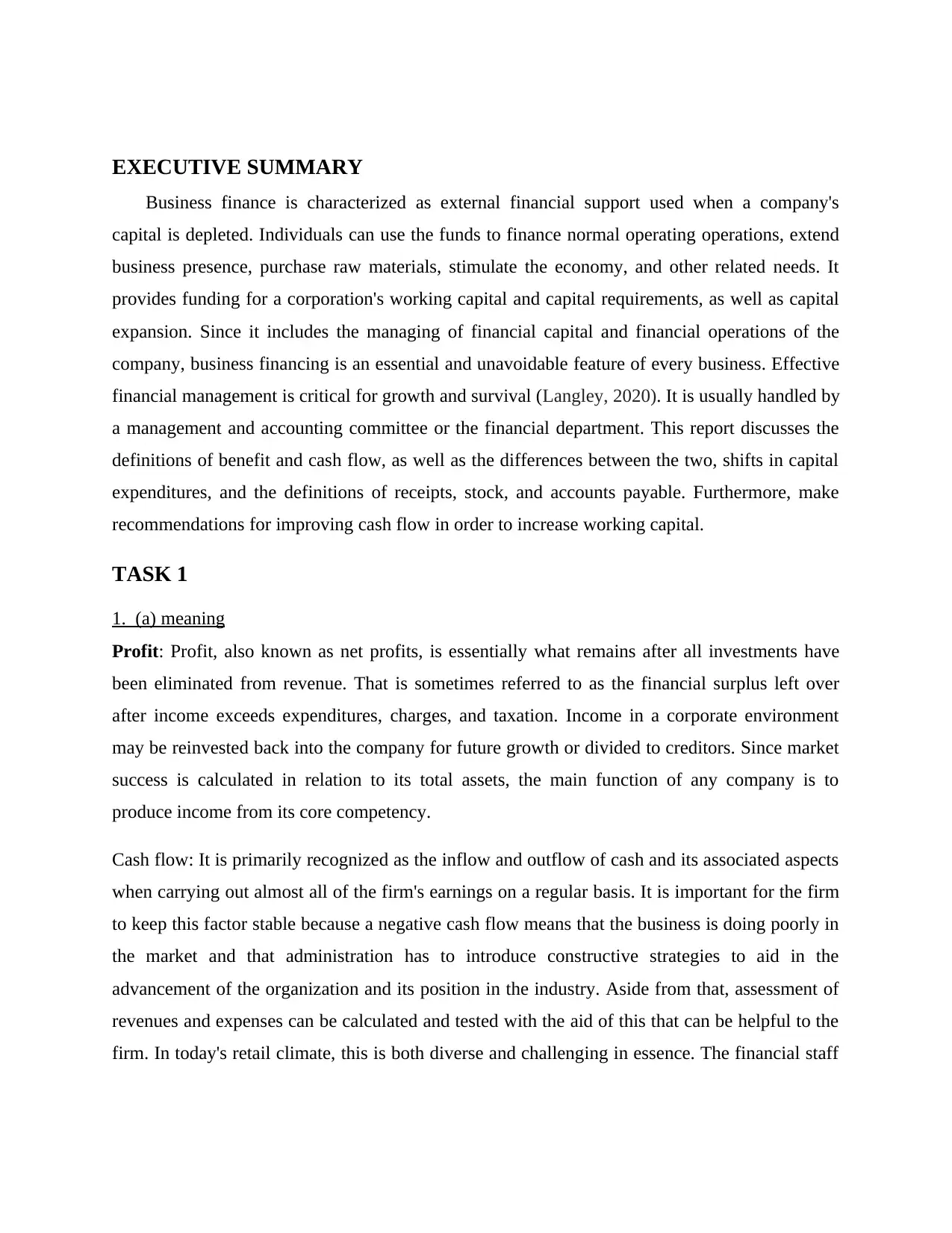
EXECUTIVE SUMMARY
Business finance is characterized as external financial support used when a company's
capital is depleted. Individuals can use the funds to finance normal operating operations, extend
business presence, purchase raw materials, stimulate the economy, and other related needs. It
provides funding for a corporation's working capital and capital requirements, as well as capital
expansion. Since it includes the managing of financial capital and financial operations of the
company, business financing is an essential and unavoidable feature of every business. Effective
financial management is critical for growth and survival (Langley, 2020). It is usually handled by
a management and accounting committee or the financial department. This report discusses the
definitions of benefit and cash flow, as well as the differences between the two, shifts in capital
expenditures, and the definitions of receipts, stock, and accounts payable. Furthermore, make
recommendations for improving cash flow in order to increase working capital.
TASK 1
1. (a) meaning
Profit: Profit, also known as net profits, is essentially what remains after all investments have
been eliminated from revenue. That is sometimes referred to as the financial surplus left over
after income exceeds expenditures, charges, and taxation. Income in a corporate environment
may be reinvested back into the company for future growth or divided to creditors. Since market
success is calculated in relation to its total assets, the main function of any company is to
produce income from its core competency.
Cash flow: It is primarily recognized as the inflow and outflow of cash and its associated aspects
when carrying out almost all of the firm's earnings on a regular basis. It is important for the firm
to keep this factor stable because a negative cash flow means that the business is doing poorly in
the market and that administration has to introduce constructive strategies to aid in the
advancement of the organization and its position in the industry. Aside from that, assessment of
revenues and expenses can be calculated and tested with the aid of this that can be helpful to the
firm. In today's retail climate, this is both diverse and challenging in essence. The financial staff
Business finance is characterized as external financial support used when a company's
capital is depleted. Individuals can use the funds to finance normal operating operations, extend
business presence, purchase raw materials, stimulate the economy, and other related needs. It
provides funding for a corporation's working capital and capital requirements, as well as capital
expansion. Since it includes the managing of financial capital and financial operations of the
company, business financing is an essential and unavoidable feature of every business. Effective
financial management is critical for growth and survival (Langley, 2020). It is usually handled by
a management and accounting committee or the financial department. This report discusses the
definitions of benefit and cash flow, as well as the differences between the two, shifts in capital
expenditures, and the definitions of receipts, stock, and accounts payable. Furthermore, make
recommendations for improving cash flow in order to increase working capital.
TASK 1
1. (a) meaning
Profit: Profit, also known as net profits, is essentially what remains after all investments have
been eliminated from revenue. That is sometimes referred to as the financial surplus left over
after income exceeds expenditures, charges, and taxation. Income in a corporate environment
may be reinvested back into the company for future growth or divided to creditors. Since market
success is calculated in relation to its total assets, the main function of any company is to
produce income from its core competency.
Cash flow: It is primarily recognized as the inflow and outflow of cash and its associated aspects
when carrying out almost all of the firm's earnings on a regular basis. It is important for the firm
to keep this factor stable because a negative cash flow means that the business is doing poorly in
the market and that administration has to introduce constructive strategies to aid in the
advancement of the organization and its position in the industry. Aside from that, assessment of
revenues and expenses can be calculated and tested with the aid of this that can be helpful to the
firm. In today's retail climate, this is both diverse and challenging in essence. The financial staff
Paraphrase This Document
Need a fresh take? Get an instant paraphrase of this document with our AI Paraphraser
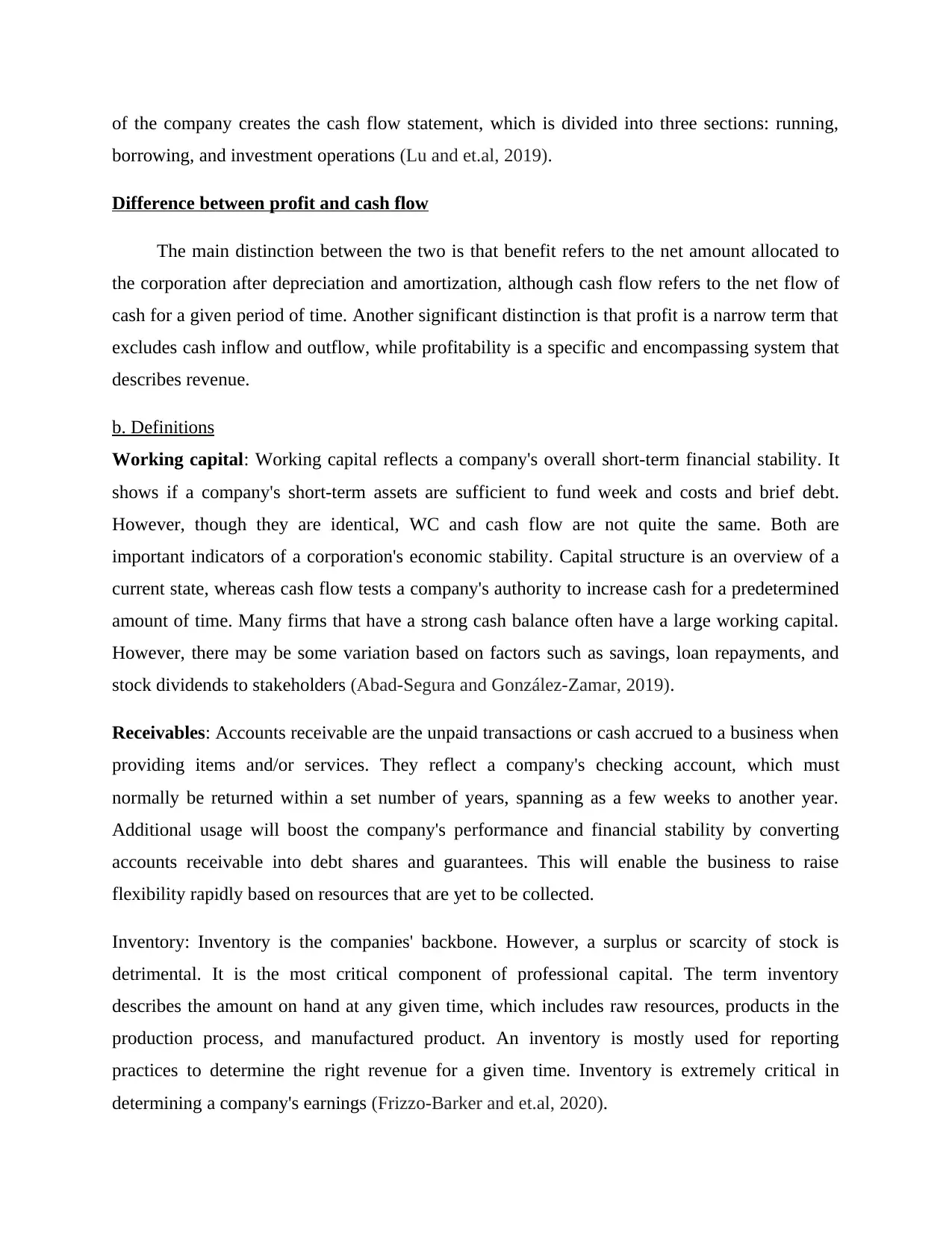
of the company creates the cash flow statement, which is divided into three sections: running,
borrowing, and investment operations (Lu and et.al, 2019).
Difference between profit and cash flow
The main distinction between the two is that benefit refers to the net amount allocated to
the corporation after depreciation and amortization, although cash flow refers to the net flow of
cash for a given period of time. Another significant distinction is that profit is a narrow term that
excludes cash inflow and outflow, while profitability is a specific and encompassing system that
describes revenue.
b. Definitions
Working capital: Working capital reflects a company's overall short-term financial stability. It
shows if a company's short-term assets are sufficient to fund week and costs and brief debt.
However, though they are identical, WC and cash flow are not quite the same. Both are
important indicators of a corporation's economic stability. Capital structure is an overview of a
current state, whereas cash flow tests a company's authority to increase cash for a predetermined
amount of time. Many firms that have a strong cash balance often have a large working capital.
However, there may be some variation based on factors such as savings, loan repayments, and
stock dividends to stakeholders (Abad-Segura and González-Zamar, 2019).
Receivables: Accounts receivable are the unpaid transactions or cash accrued to a business when
providing items and/or services. They reflect a company's checking account, which must
normally be returned within a set number of years, spanning as a few weeks to another year.
Additional usage will boost the company's performance and financial stability by converting
accounts receivable into debt shares and guarantees. This will enable the business to raise
flexibility rapidly based on resources that are yet to be collected.
Inventory: Inventory is the companies' backbone. However, a surplus or scarcity of stock is
detrimental. It is the most critical component of professional capital. The term inventory
describes the amount on hand at any given time, which includes raw resources, products in the
production process, and manufactured product. An inventory is mostly used for reporting
practices to determine the right revenue for a given time. Inventory is extremely critical in
determining a company's earnings (Frizzo-Barker and et.al, 2020).
borrowing, and investment operations (Lu and et.al, 2019).
Difference between profit and cash flow
The main distinction between the two is that benefit refers to the net amount allocated to
the corporation after depreciation and amortization, although cash flow refers to the net flow of
cash for a given period of time. Another significant distinction is that profit is a narrow term that
excludes cash inflow and outflow, while profitability is a specific and encompassing system that
describes revenue.
b. Definitions
Working capital: Working capital reflects a company's overall short-term financial stability. It
shows if a company's short-term assets are sufficient to fund week and costs and brief debt.
However, though they are identical, WC and cash flow are not quite the same. Both are
important indicators of a corporation's economic stability. Capital structure is an overview of a
current state, whereas cash flow tests a company's authority to increase cash for a predetermined
amount of time. Many firms that have a strong cash balance often have a large working capital.
However, there may be some variation based on factors such as savings, loan repayments, and
stock dividends to stakeholders (Abad-Segura and González-Zamar, 2019).
Receivables: Accounts receivable are the unpaid transactions or cash accrued to a business when
providing items and/or services. They reflect a company's checking account, which must
normally be returned within a set number of years, spanning as a few weeks to another year.
Additional usage will boost the company's performance and financial stability by converting
accounts receivable into debt shares and guarantees. This will enable the business to raise
flexibility rapidly based on resources that are yet to be collected.
Inventory: Inventory is the companies' backbone. However, a surplus or scarcity of stock is
detrimental. It is the most critical component of professional capital. The term inventory
describes the amount on hand at any given time, which includes raw resources, products in the
production process, and manufactured product. An inventory is mostly used for reporting
practices to determine the right revenue for a given time. Inventory is extremely critical in
determining a company's earnings (Frizzo-Barker and et.al, 2020).
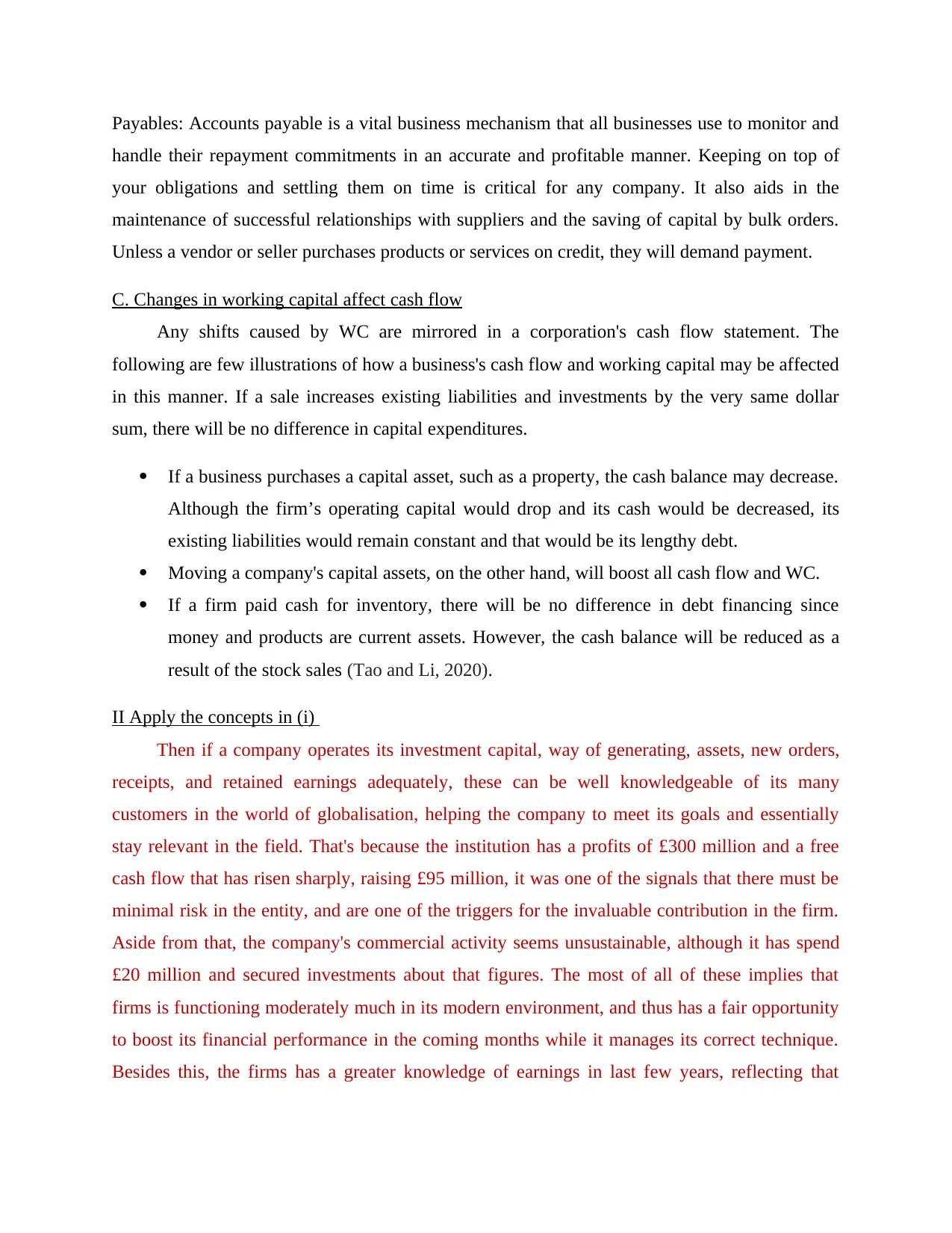
Payables: Accounts payable is a vital business mechanism that all businesses use to monitor and
handle their repayment commitments in an accurate and profitable manner. Keeping on top of
your obligations and settling them on time is critical for any company. It also aids in the
maintenance of successful relationships with suppliers and the saving of capital by bulk orders.
Unless a vendor or seller purchases products or services on credit, they will demand payment.
C. Changes in working capital affect cash flow
Any shifts caused by WC are mirrored in a corporation's cash flow statement. The
following are few illustrations of how a business's cash flow and working capital may be affected
in this manner. If a sale increases existing liabilities and investments by the very same dollar
sum, there will be no difference in capital expenditures.
If a business purchases a capital asset, such as a property, the cash balance may decrease.
Although the firm’s operating capital would drop and its cash would be decreased, its
existing liabilities would remain constant and that would be its lengthy debt.
Moving a company's capital assets, on the other hand, will boost all cash flow and WC.
If a firm paid cash for inventory, there will be no difference in debt financing since
money and products are current assets. However, the cash balance will be reduced as a
result of the stock sales (Tao and Li, 2020).
II Apply the concepts in (i)
Then if a company operates its investment capital, way of generating, assets, new orders,
receipts, and retained earnings adequately, these can be well knowledgeable of its many
customers in the world of globalisation, helping the company to meet its goals and essentially
stay relevant in the field. That's because the institution has a profits of £300 million and a free
cash flow that has risen sharply, raising £95 million, it was one of the signals that there must be
minimal risk in the entity, and are one of the triggers for the invaluable contribution in the firm.
Aside from that, the company's commercial activity seems unsustainable, although it has spend
£20 million and secured investments about that figures. The most of all of these implies that
firms is functioning moderately much in its modern environment, and thus has a fair opportunity
to boost its financial performance in the coming months while it manages its correct technique.
Besides this, the firms has a greater knowledge of earnings in last few years, reflecting that
handle their repayment commitments in an accurate and profitable manner. Keeping on top of
your obligations and settling them on time is critical for any company. It also aids in the
maintenance of successful relationships with suppliers and the saving of capital by bulk orders.
Unless a vendor or seller purchases products or services on credit, they will demand payment.
C. Changes in working capital affect cash flow
Any shifts caused by WC are mirrored in a corporation's cash flow statement. The
following are few illustrations of how a business's cash flow and working capital may be affected
in this manner. If a sale increases existing liabilities and investments by the very same dollar
sum, there will be no difference in capital expenditures.
If a business purchases a capital asset, such as a property, the cash balance may decrease.
Although the firm’s operating capital would drop and its cash would be decreased, its
existing liabilities would remain constant and that would be its lengthy debt.
Moving a company's capital assets, on the other hand, will boost all cash flow and WC.
If a firm paid cash for inventory, there will be no difference in debt financing since
money and products are current assets. However, the cash balance will be reduced as a
result of the stock sales (Tao and Li, 2020).
II Apply the concepts in (i)
Then if a company operates its investment capital, way of generating, assets, new orders,
receipts, and retained earnings adequately, these can be well knowledgeable of its many
customers in the world of globalisation, helping the company to meet its goals and essentially
stay relevant in the field. That's because the institution has a profits of £300 million and a free
cash flow that has risen sharply, raising £95 million, it was one of the signals that there must be
minimal risk in the entity, and are one of the triggers for the invaluable contribution in the firm.
Aside from that, the company's commercial activity seems unsustainable, although it has spend
£20 million and secured investments about that figures. The most of all of these implies that
firms is functioning moderately much in its modern environment, and thus has a fair opportunity
to boost its financial performance in the coming months while it manages its correct technique.
Besides this, the firms has a greater knowledge of earnings in last few years, reflecting that
⊘ This is a preview!⊘
Do you want full access?
Subscribe today to unlock all pages.

Trusted by 1+ million students worldwide
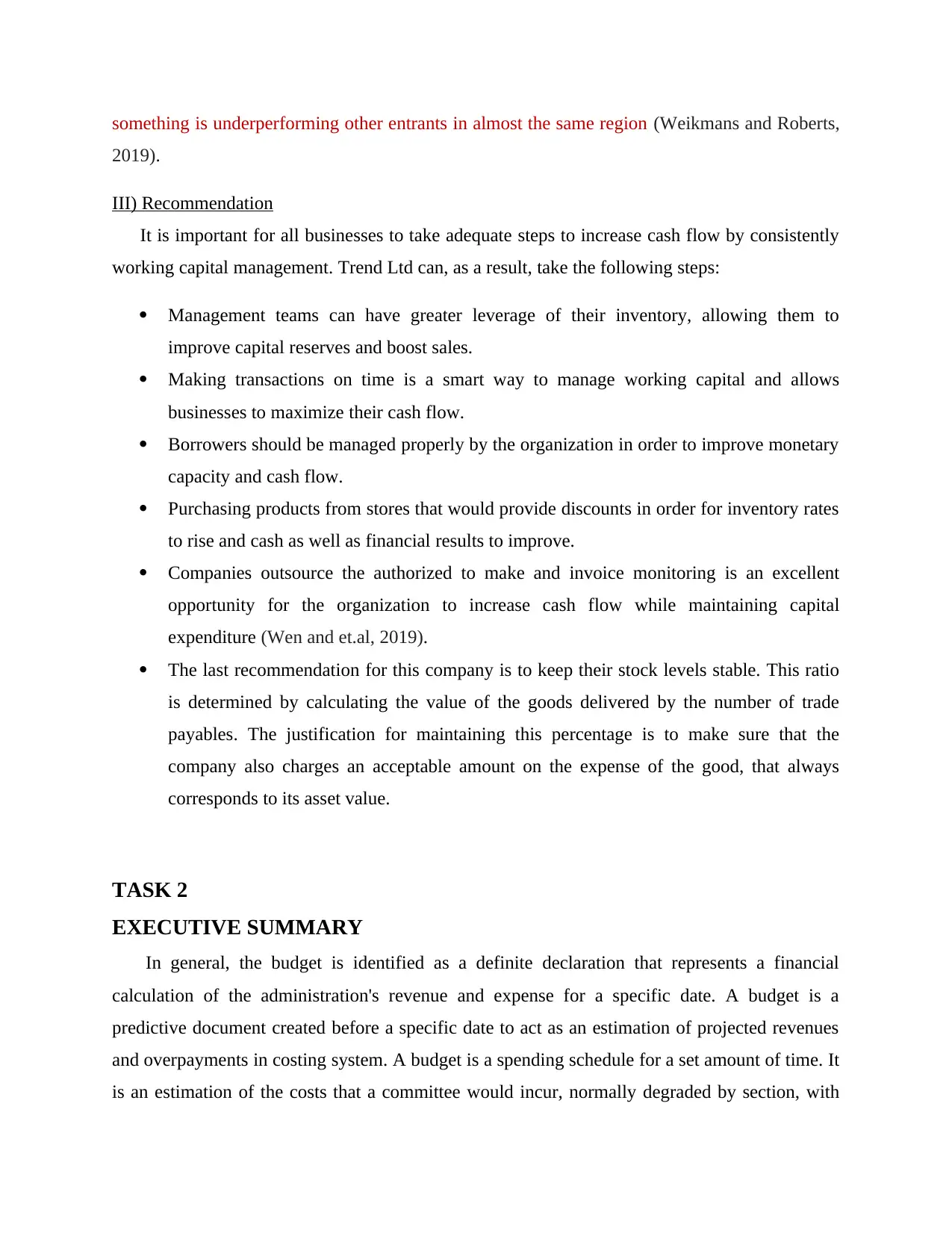
something is underperforming other entrants in almost the same region (Weikmans and Roberts,
2019).
III) Recommendation
It is important for all businesses to take adequate steps to increase cash flow by consistently
working capital management. Trend Ltd can, as a result, take the following steps:
Management teams can have greater leverage of their inventory, allowing them to
improve capital reserves and boost sales.
Making transactions on time is a smart way to manage working capital and allows
businesses to maximize their cash flow.
Borrowers should be managed properly by the organization in order to improve monetary
capacity and cash flow.
Purchasing products from stores that would provide discounts in order for inventory rates
to rise and cash as well as financial results to improve.
Companies outsource the authorized to make and invoice monitoring is an excellent
opportunity for the organization to increase cash flow while maintaining capital
expenditure (Wen and et.al, 2019).
The last recommendation for this company is to keep their stock levels stable. This ratio
is determined by calculating the value of the goods delivered by the number of trade
payables. The justification for maintaining this percentage is to make sure that the
company also charges an acceptable amount on the expense of the good, that always
corresponds to its asset value.
TASK 2
EXECUTIVE SUMMARY
In general, the budget is identified as a definite declaration that represents a financial
calculation of the administration's revenue and expense for a specific date. A budget is a
predictive document created before a specific date to act as an estimation of projected revenues
and overpayments in costing system. A budget is a spending schedule for a set amount of time. It
is an estimation of the costs that a committee would incur, normally degraded by section, with
2019).
III) Recommendation
It is important for all businesses to take adequate steps to increase cash flow by consistently
working capital management. Trend Ltd can, as a result, take the following steps:
Management teams can have greater leverage of their inventory, allowing them to
improve capital reserves and boost sales.
Making transactions on time is a smart way to manage working capital and allows
businesses to maximize their cash flow.
Borrowers should be managed properly by the organization in order to improve monetary
capacity and cash flow.
Purchasing products from stores that would provide discounts in order for inventory rates
to rise and cash as well as financial results to improve.
Companies outsource the authorized to make and invoice monitoring is an excellent
opportunity for the organization to increase cash flow while maintaining capital
expenditure (Wen and et.al, 2019).
The last recommendation for this company is to keep their stock levels stable. This ratio
is determined by calculating the value of the goods delivered by the number of trade
payables. The justification for maintaining this percentage is to make sure that the
company also charges an acceptable amount on the expense of the good, that always
corresponds to its asset value.
TASK 2
EXECUTIVE SUMMARY
In general, the budget is identified as a definite declaration that represents a financial
calculation of the administration's revenue and expense for a specific date. A budget is a
predictive document created before a specific date to act as an estimation of projected revenues
and overpayments in costing system. A budget is a spending schedule for a set amount of time. It
is an estimation of the costs that a committee would incur, normally degraded by section, with
Paraphrase This Document
Need a fresh take? Get an instant paraphrase of this document with our AI Paraphraser
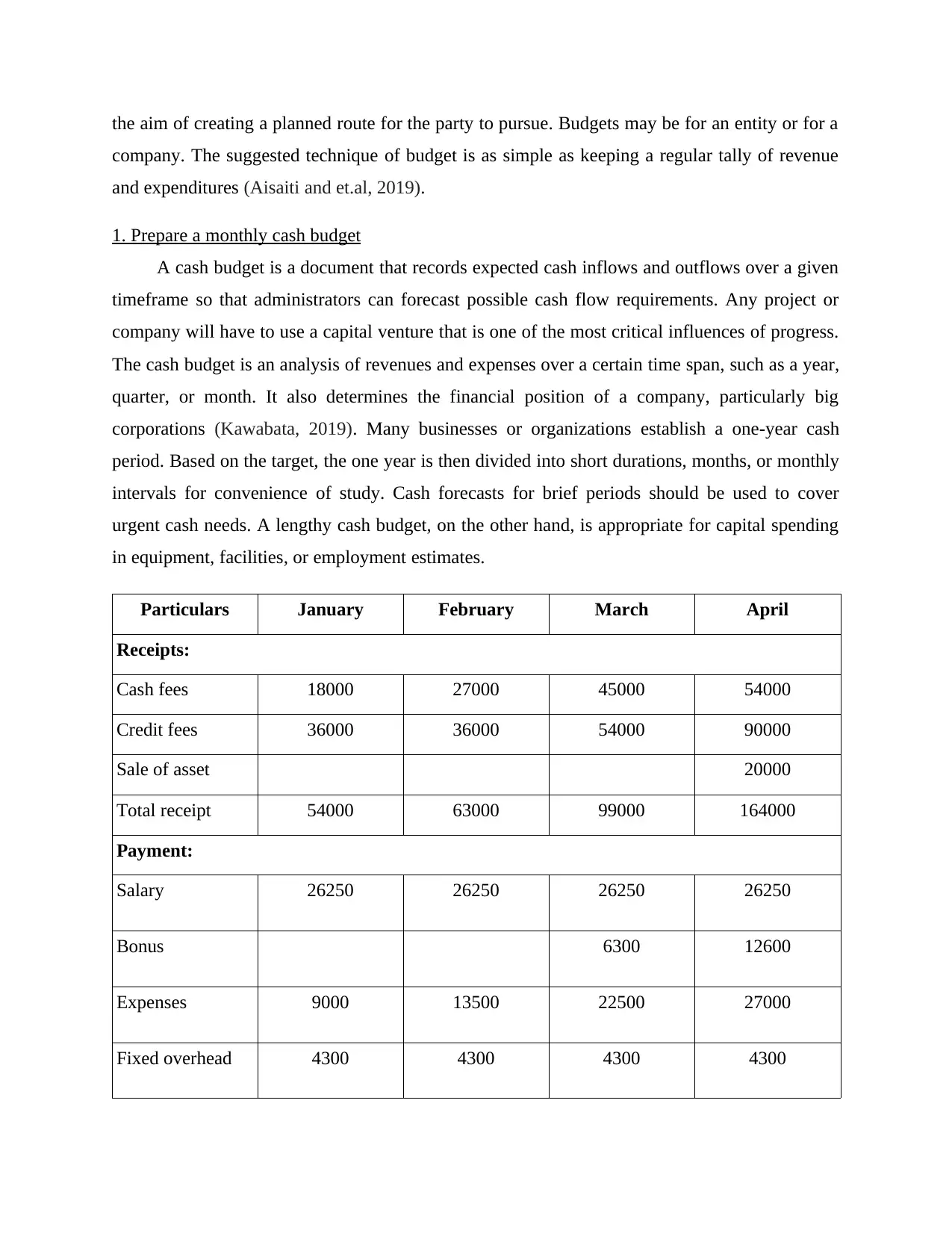
the aim of creating a planned route for the party to pursue. Budgets may be for an entity or for a
company. The suggested technique of budget is as simple as keeping a regular tally of revenue
and expenditures (Aisaiti and et.al, 2019).
1. Prepare a monthly cash budget
A cash budget is a document that records expected cash inflows and outflows over a given
timeframe so that administrators can forecast possible cash flow requirements. Any project or
company will have to use a capital venture that is one of the most critical influences of progress.
The cash budget is an analysis of revenues and expenses over a certain time span, such as a year,
quarter, or month. It also determines the financial position of a company, particularly big
corporations (Kawabata, 2019). Many businesses or organizations establish a one-year cash
period. Based on the target, the one year is then divided into short durations, months, or monthly
intervals for convenience of study. Cash forecasts for brief periods should be used to cover
urgent cash needs. A lengthy cash budget, on the other hand, is appropriate for capital spending
in equipment, facilities, or employment estimates.
Particulars January February March April
Receipts:
Cash fees 18000 27000 45000 54000
Credit fees 36000 36000 54000 90000
Sale of asset 20000
Total receipt 54000 63000 99000 164000
Payment:
Salary 26250 26250 26250 26250
Bonus 6300 12600
Expenses 9000 13500 22500 27000
Fixed overhead 4300 4300 4300 4300
company. The suggested technique of budget is as simple as keeping a regular tally of revenue
and expenditures (Aisaiti and et.al, 2019).
1. Prepare a monthly cash budget
A cash budget is a document that records expected cash inflows and outflows over a given
timeframe so that administrators can forecast possible cash flow requirements. Any project or
company will have to use a capital venture that is one of the most critical influences of progress.
The cash budget is an analysis of revenues and expenses over a certain time span, such as a year,
quarter, or month. It also determines the financial position of a company, particularly big
corporations (Kawabata, 2019). Many businesses or organizations establish a one-year cash
period. Based on the target, the one year is then divided into short durations, months, or monthly
intervals for convenience of study. Cash forecasts for brief periods should be used to cover
urgent cash needs. A lengthy cash budget, on the other hand, is appropriate for capital spending
in equipment, facilities, or employment estimates.
Particulars January February March April
Receipts:
Cash fees 18000 27000 45000 54000
Credit fees 36000 36000 54000 90000
Sale of asset 20000
Total receipt 54000 63000 99000 164000
Payment:
Salary 26250 26250 26250 26250
Bonus 6300 12600
Expenses 9000 13500 22500 27000
Fixed overhead 4300 4300 4300 4300
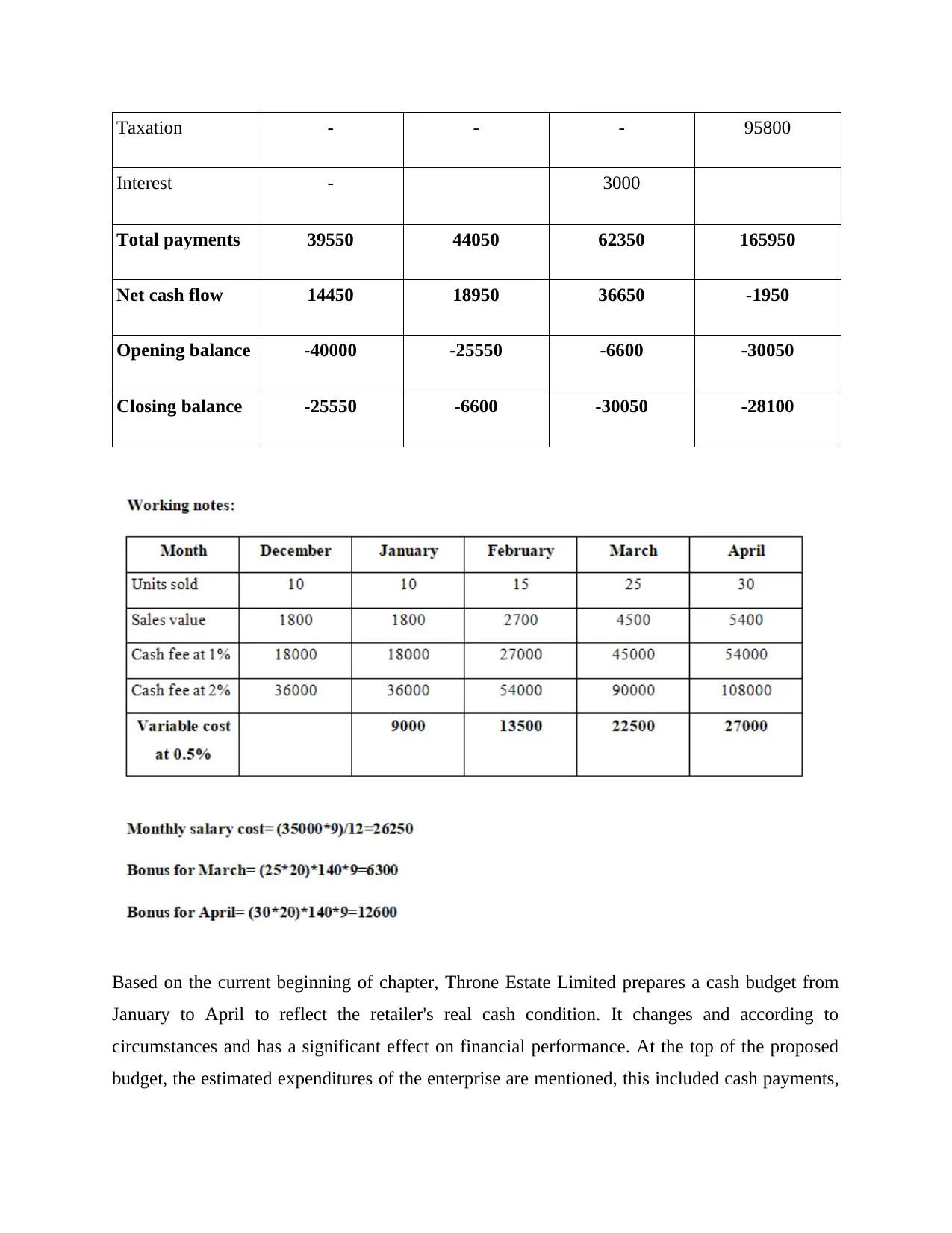
Taxation - - - 95800
Interest - 3000
Total payments 39550 44050 62350 165950
Net cash flow 14450 18950 36650 -1950
Opening balance -40000 -25550 -6600 -30050
Closing balance -25550 -6600 -30050 -28100
Based on the current beginning of chapter, Throne Estate Limited prepares a cash budget from
January to April to reflect the retailer's real cash condition. It changes and according to
circumstances and has a significant effect on financial performance. At the top of the proposed
budget, the estimated expenditures of the enterprise are mentioned, this included cash payments,
Interest - 3000
Total payments 39550 44050 62350 165950
Net cash flow 14450 18950 36650 -1950
Opening balance -40000 -25550 -6600 -30050
Closing balance -25550 -6600 -30050 -28100
Based on the current beginning of chapter, Throne Estate Limited prepares a cash budget from
January to April to reflect the retailer's real cash condition. It changes and according to
circumstances and has a significant effect on financial performance. At the top of the proposed
budget, the estimated expenditures of the enterprise are mentioned, this included cash payments,
⊘ This is a preview!⊘
Do you want full access?
Subscribe today to unlock all pages.

Trusted by 1+ million students worldwide
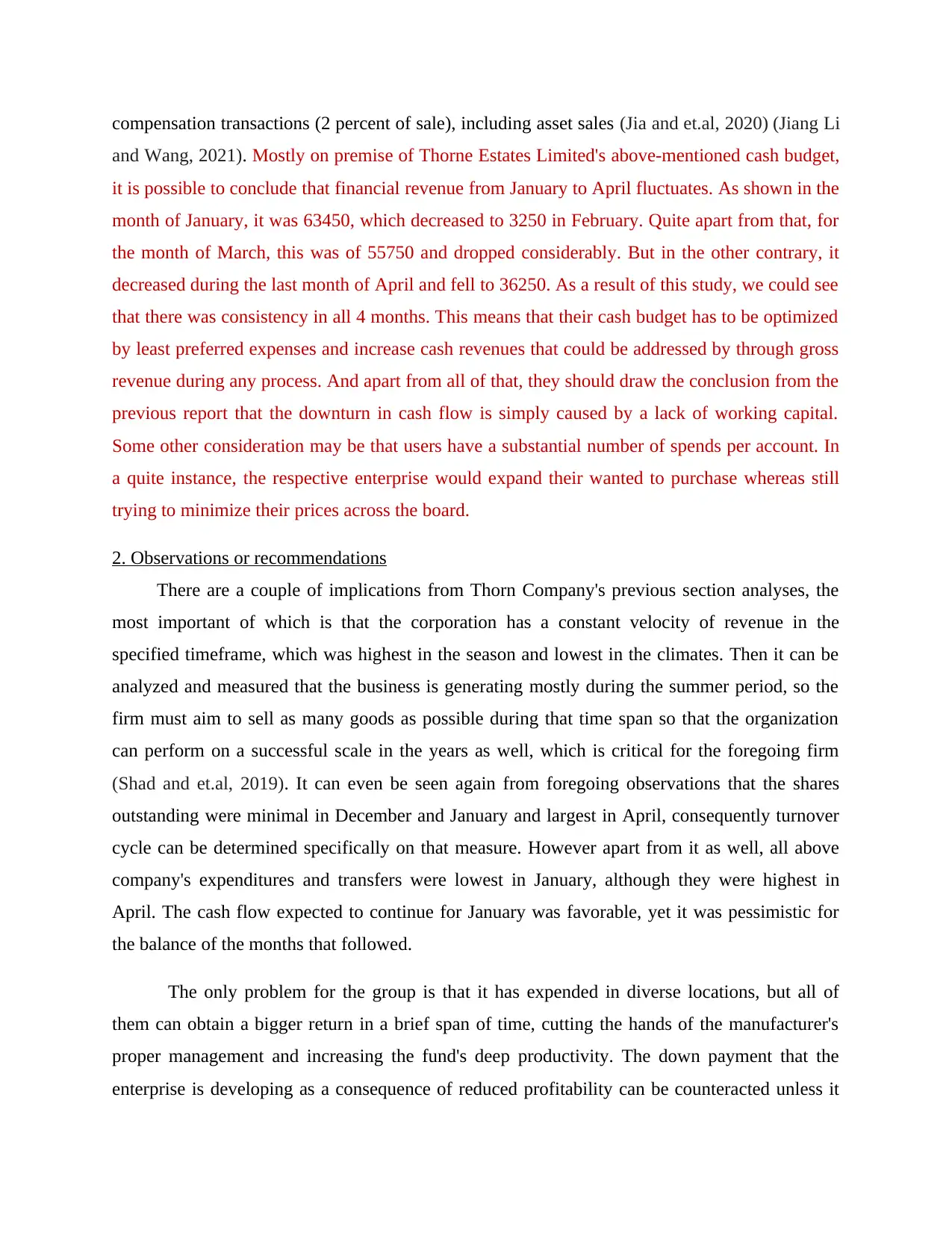
compensation transactions (2 percent of sale), including asset sales (Jia and et.al, 2020) (Jiang Li
and Wang, 2021). Mostly on premise of Thorne Estates Limited's above-mentioned cash budget,
it is possible to conclude that financial revenue from January to April fluctuates. As shown in the
month of January, it was 63450, which decreased to 3250 in February. Quite apart from that, for
the month of March, this was of 55750 and dropped considerably. But in the other contrary, it
decreased during the last month of April and fell to 36250. As a result of this study, we could see
that there was consistency in all 4 months. This means that their cash budget has to be optimized
by least preferred expenses and increase cash revenues that could be addressed by through gross
revenue during any process. And apart from all of that, they should draw the conclusion from the
previous report that the downturn in cash flow is simply caused by a lack of working capital.
Some other consideration may be that users have a substantial number of spends per account. In
a quite instance, the respective enterprise would expand their wanted to purchase whereas still
trying to minimize their prices across the board.
2. Observations or recommendations
There are a couple of implications from Thorn Company's previous section analyses, the
most important of which is that the corporation has a constant velocity of revenue in the
specified timeframe, which was highest in the season and lowest in the climates. Then it can be
analyzed and measured that the business is generating mostly during the summer period, so the
firm must aim to sell as many goods as possible during that time span so that the organization
can perform on a successful scale in the years as well, which is critical for the foregoing firm
(Shad and et.al, 2019). It can even be seen again from foregoing observations that the shares
outstanding were minimal in December and January and largest in April, consequently turnover
cycle can be determined specifically on that measure. However apart from it as well, all above
company's expenditures and transfers were lowest in January, although they were highest in
April. The cash flow expected to continue for January was favorable, yet it was pessimistic for
the balance of the months that followed.
The only problem for the group is that it has expended in diverse locations, but all of
them can obtain a bigger return in a brief span of time, cutting the hands of the manufacturer's
proper management and increasing the fund's deep productivity. The down payment that the
enterprise is developing as a consequence of reduced profitability can be counteracted unless it
and Wang, 2021). Mostly on premise of Thorne Estates Limited's above-mentioned cash budget,
it is possible to conclude that financial revenue from January to April fluctuates. As shown in the
month of January, it was 63450, which decreased to 3250 in February. Quite apart from that, for
the month of March, this was of 55750 and dropped considerably. But in the other contrary, it
decreased during the last month of April and fell to 36250. As a result of this study, we could see
that there was consistency in all 4 months. This means that their cash budget has to be optimized
by least preferred expenses and increase cash revenues that could be addressed by through gross
revenue during any process. And apart from all of that, they should draw the conclusion from the
previous report that the downturn in cash flow is simply caused by a lack of working capital.
Some other consideration may be that users have a substantial number of spends per account. In
a quite instance, the respective enterprise would expand their wanted to purchase whereas still
trying to minimize their prices across the board.
2. Observations or recommendations
There are a couple of implications from Thorn Company's previous section analyses, the
most important of which is that the corporation has a constant velocity of revenue in the
specified timeframe, which was highest in the season and lowest in the climates. Then it can be
analyzed and measured that the business is generating mostly during the summer period, so the
firm must aim to sell as many goods as possible during that time span so that the organization
can perform on a successful scale in the years as well, which is critical for the foregoing firm
(Shad and et.al, 2019). It can even be seen again from foregoing observations that the shares
outstanding were minimal in December and January and largest in April, consequently turnover
cycle can be determined specifically on that measure. However apart from it as well, all above
company's expenditures and transfers were lowest in January, although they were highest in
April. The cash flow expected to continue for January was favorable, yet it was pessimistic for
the balance of the months that followed.
The only problem for the group is that it has expended in diverse locations, but all of
them can obtain a bigger return in a brief span of time, cutting the hands of the manufacturer's
proper management and increasing the fund's deep productivity. The down payment that the
enterprise is developing as a consequence of reduced profitability can be counteracted unless it
Paraphrase This Document
Need a fresh take? Get an instant paraphrase of this document with our AI Paraphraser
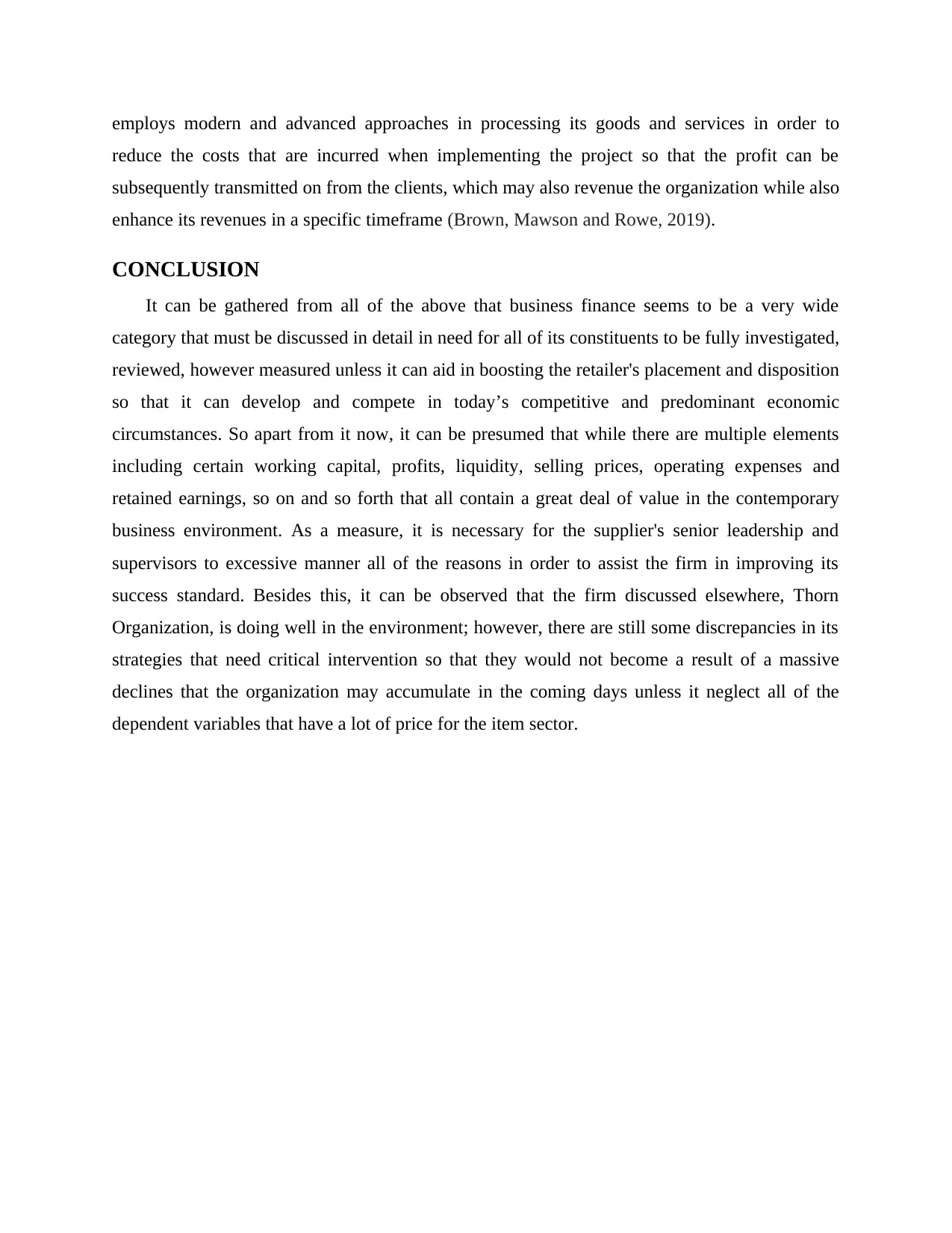
employs modern and advanced approaches in processing its goods and services in order to
reduce the costs that are incurred when implementing the project so that the profit can be
subsequently transmitted on from the clients, which may also revenue the organization while also
enhance its revenues in a specific timeframe (Brown, Mawson and Rowe, 2019).
CONCLUSION
It can be gathered from all of the above that business finance seems to be a very wide
category that must be discussed in detail in need for all of its constituents to be fully investigated,
reviewed, however measured unless it can aid in boosting the retailer's placement and disposition
so that it can develop and compete in today’s competitive and predominant economic
circumstances. So apart from it now, it can be presumed that while there are multiple elements
including certain working capital, profits, liquidity, selling prices, operating expenses and
retained earnings, so on and so forth that all contain a great deal of value in the contemporary
business environment. As a measure, it is necessary for the supplier's senior leadership and
supervisors to excessive manner all of the reasons in order to assist the firm in improving its
success standard. Besides this, it can be observed that the firm discussed elsewhere, Thorn
Organization, is doing well in the environment; however, there are still some discrepancies in its
strategies that need critical intervention so that they would not become a result of a massive
declines that the organization may accumulate in the coming days unless it neglect all of the
dependent variables that have a lot of price for the item sector.
reduce the costs that are incurred when implementing the project so that the profit can be
subsequently transmitted on from the clients, which may also revenue the organization while also
enhance its revenues in a specific timeframe (Brown, Mawson and Rowe, 2019).
CONCLUSION
It can be gathered from all of the above that business finance seems to be a very wide
category that must be discussed in detail in need for all of its constituents to be fully investigated,
reviewed, however measured unless it can aid in boosting the retailer's placement and disposition
so that it can develop and compete in today’s competitive and predominant economic
circumstances. So apart from it now, it can be presumed that while there are multiple elements
including certain working capital, profits, liquidity, selling prices, operating expenses and
retained earnings, so on and so forth that all contain a great deal of value in the contemporary
business environment. As a measure, it is necessary for the supplier's senior leadership and
supervisors to excessive manner all of the reasons in order to assist the firm in improving its
success standard. Besides this, it can be observed that the firm discussed elsewhere, Thorn
Organization, is doing well in the environment; however, there are still some discrepancies in its
strategies that need critical intervention so that they would not become a result of a massive
declines that the organization may accumulate in the coming days unless it neglect all of the
dependent variables that have a lot of price for the item sector.
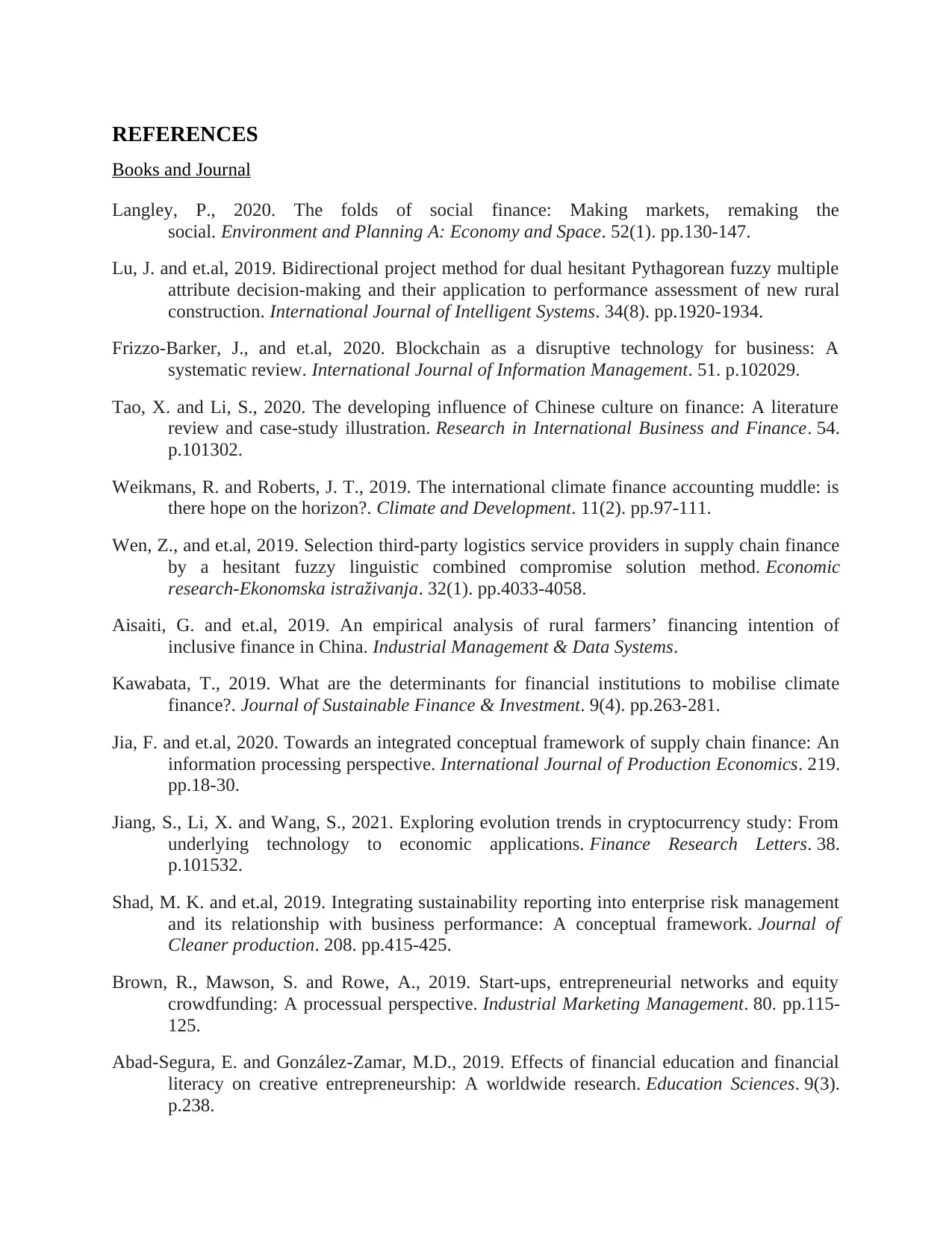
REFERENCES
Books and Journal
Langley, P., 2020. The folds of social finance: Making markets, remaking the
social. Environment and Planning A: Economy and Space. 52(1). pp.130-147.
Lu, J. and et.al, 2019. Bidirectional project method for dual hesitant Pythagorean fuzzy multiple
attribute decision‐making and their application to performance assessment of new rural
construction. International Journal of Intelligent Systems. 34(8). pp.1920-1934.
Frizzo-Barker, J., and et.al, 2020. Blockchain as a disruptive technology for business: A
systematic review. International Journal of Information Management. 51. p.102029.
Tao, X. and Li, S., 2020. The developing influence of Chinese culture on finance: A literature
review and case-study illustration. Research in International Business and Finance. 54.
p.101302.
Weikmans, R. and Roberts, J. T., 2019. The international climate finance accounting muddle: is
there hope on the horizon?. Climate and Development. 11(2). pp.97-111.
Wen, Z., and et.al, 2019. Selection third-party logistics service providers in supply chain finance
by a hesitant fuzzy linguistic combined compromise solution method. Economic
research-Ekonomska istraživanja. 32(1). pp.4033-4058.
Aisaiti, G. and et.al, 2019. An empirical analysis of rural farmers’ financing intention of
inclusive finance in China. Industrial Management & Data Systems.
Kawabata, T., 2019. What are the determinants for financial institutions to mobilise climate
finance?. Journal of Sustainable Finance & Investment. 9(4). pp.263-281.
Jia, F. and et.al, 2020. Towards an integrated conceptual framework of supply chain finance: An
information processing perspective. International Journal of Production Economics. 219.
pp.18-30.
Jiang, S., Li, X. and Wang, S., 2021. Exploring evolution trends in cryptocurrency study: From
underlying technology to economic applications. Finance Research Letters. 38.
p.101532.
Shad, M. K. and et.al, 2019. Integrating sustainability reporting into enterprise risk management
and its relationship with business performance: A conceptual framework. Journal of
Cleaner production. 208. pp.415-425.
Brown, R., Mawson, S. and Rowe, A., 2019. Start-ups, entrepreneurial networks and equity
crowdfunding: A processual perspective. Industrial Marketing Management. 80. pp.115-
125.
Abad-Segura, E. and González-Zamar, M.D., 2019. Effects of financial education and financial
literacy on creative entrepreneurship: A worldwide research. Education Sciences. 9(3).
p.238.
Books and Journal
Langley, P., 2020. The folds of social finance: Making markets, remaking the
social. Environment and Planning A: Economy and Space. 52(1). pp.130-147.
Lu, J. and et.al, 2019. Bidirectional project method for dual hesitant Pythagorean fuzzy multiple
attribute decision‐making and their application to performance assessment of new rural
construction. International Journal of Intelligent Systems. 34(8). pp.1920-1934.
Frizzo-Barker, J., and et.al, 2020. Blockchain as a disruptive technology for business: A
systematic review. International Journal of Information Management. 51. p.102029.
Tao, X. and Li, S., 2020. The developing influence of Chinese culture on finance: A literature
review and case-study illustration. Research in International Business and Finance. 54.
p.101302.
Weikmans, R. and Roberts, J. T., 2019. The international climate finance accounting muddle: is
there hope on the horizon?. Climate and Development. 11(2). pp.97-111.
Wen, Z., and et.al, 2019. Selection third-party logistics service providers in supply chain finance
by a hesitant fuzzy linguistic combined compromise solution method. Economic
research-Ekonomska istraživanja. 32(1). pp.4033-4058.
Aisaiti, G. and et.al, 2019. An empirical analysis of rural farmers’ financing intention of
inclusive finance in China. Industrial Management & Data Systems.
Kawabata, T., 2019. What are the determinants for financial institutions to mobilise climate
finance?. Journal of Sustainable Finance & Investment. 9(4). pp.263-281.
Jia, F. and et.al, 2020. Towards an integrated conceptual framework of supply chain finance: An
information processing perspective. International Journal of Production Economics. 219.
pp.18-30.
Jiang, S., Li, X. and Wang, S., 2021. Exploring evolution trends in cryptocurrency study: From
underlying technology to economic applications. Finance Research Letters. 38.
p.101532.
Shad, M. K. and et.al, 2019. Integrating sustainability reporting into enterprise risk management
and its relationship with business performance: A conceptual framework. Journal of
Cleaner production. 208. pp.415-425.
Brown, R., Mawson, S. and Rowe, A., 2019. Start-ups, entrepreneurial networks and equity
crowdfunding: A processual perspective. Industrial Marketing Management. 80. pp.115-
125.
Abad-Segura, E. and González-Zamar, M.D., 2019. Effects of financial education and financial
literacy on creative entrepreneurship: A worldwide research. Education Sciences. 9(3).
p.238.
⊘ This is a preview!⊘
Do you want full access?
Subscribe today to unlock all pages.

Trusted by 1+ million students worldwide
1 out of 13
Related Documents
Your All-in-One AI-Powered Toolkit for Academic Success.
+13062052269
info@desklib.com
Available 24*7 on WhatsApp / Email
![[object Object]](/_next/static/media/star-bottom.7253800d.svg)
Unlock your academic potential
Copyright © 2020–2025 A2Z Services. All Rights Reserved. Developed and managed by ZUCOL.





